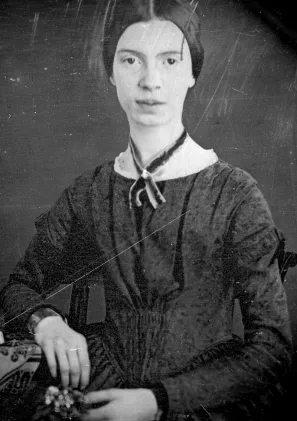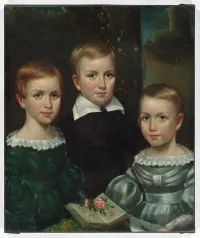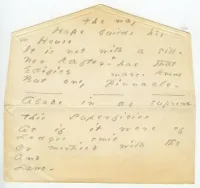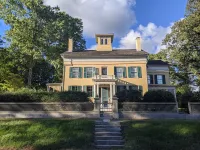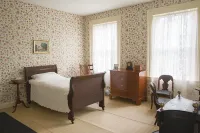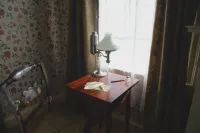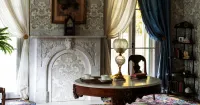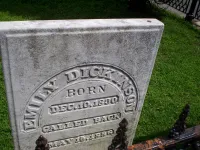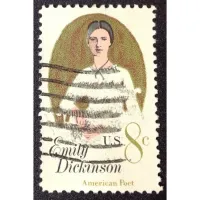Biography
1830 - 1886
“The brain is wider than the sky.”
- Emily Dickinson
Born on December 10, 1830, in Amherst, Massachusetts, Emily Dickinson is one of the most well renowned women poets of the modern era. Dickinson had an older brother William (Austin) and younger sister Lavinia. Their parents, Edward and Emily, raised Emily and her siblings in a wealthy conservative Christian household. Her father was a Massachusetts state legislator (both chambers) and a U.S. Representative. Edward’s relationship with his headstrong daughter was strained. She attended Amherst Academy where she excelled in Latin, composition, and the sciences. Later, she wished to go to college and attended Mount Holyoke Female Seminary. Unhappy with the harsh rules, she left after just one year. Dickinson’s talent went unrecognized during her lifetime and it wasn’t until she had died that her family discovered forty self-bound books containing nearly 1,800 of Emily’s poems. Religious hymns and the Metaphysical poetry of seventeenth century England had influenced Dickinson’s work, along with the poetry of John Keats and Elizabeth Barrett Browning. Some of her poems were published in the Springfield Daily Republican newspaper anonymously during her lifetime. The majority of her poetry can be seen in her letters to friends and loved ones. In her letters to Susan Gilbert, her best friend and sister-in-law, readers and scholars alike believe that Dickinson’s writing was romantic and love driven. In one of Dickinson’s many letters to Susan, she writes: “If you were here — and Oh that you were, my Susie, we need not talk at all, our eyes would whisper for us, and your hand fast in mine, we would not ask for language.” Ten of her poems were published when she was alive but her first volume of work was published four years after her death in 1890 and the last in 1955. Dickinson passed away at the age of 55 in her hometown, Amherst, from what doctors now believe was hypertension. Her childhood home is now a museum dedicated to educating the public about her life Some of her most famous poems are: Success is counted sweetest, “Hope” is the thing with feathers, This is my letter to the World, and I’m Nobody.
1830 - 1886
“The brain is wider than the sky.”
- Emily Dickinson
Born on December 10, 1830, in Amherst, Massachusetts, Emily Dickinson is one of the most well renowned women poets of the modern era. Dickinson had an older brother William (Austin) and younger sister Lavinia. Their parents, Edward and Emily, raised Emily and her siblings in a wealthy conservative Christian household. Her father was a Massachusetts state legislator (both chambers) and a U.S. Representative. Edward’s relationship with his headstrong daughter was strained. She attended Amherst Academy where she excelled in Latin, composition, and the sciences. Later, she wished to go to college and attended Mount Holyoke Female Seminary. Unhappy with the harsh rules, she left after just one year. Dickinson’s talent went unrecognized during her lifetime and it wasn’t until she had died that her family discovered forty self-bound books containing nearly 1,800 of Emily’s poems. Religious hymns and the Metaphysical poetry of seventeenth century England had influenced Dickinson’s work, along with the poetry of John Keats and Elizabeth Barrett Browning. Some of her poems were published in the Springfield Daily Republican newspaper anonymously during her lifetime. The majority of her poetry can be seen in her letters to friends and loved ones. In her letters to Susan Gilbert, her best friend and sister-in-law, readers and scholars alike believe that Dickinson’s writing was romantic and love driven. In one of Dickinson’s many letters to Susan, she writes: “If you were here — and Oh that you were, my Susie, we need not talk at all, our eyes would whisper for us, and your hand fast in mine, we would not ask for language.” Ten of her poems were published when she was alive but her first volume of work was published four years after her death in 1890 and the last in 1955. Dickinson passed away at the age of 55 in her hometown, Amherst, from what doctors now believe was hypertension. Her childhood home is now a museum dedicated to educating the public about her life Some of her most famous poems are: Success is counted sweetest, “Hope” is the thing with feathers, This is my letter to the World, and I’m Nobody.
Demography
Demography
Gender Female
Sexual Orientation Queer
Gender Identity Cisgender
Ethnicity Caucasian/White
Faith Construct Protestant
Nations Affiliated United States
Era/Epoch Victorian Era (1837-1901)
Field(s) of Contribution
Author
Poet
Social Sciences
US History
Commemorations & Honors
Several Schools Named in Her Honor
U.S. Postal Service Commemorative Stamp (1971)
National Women's Halls of Fame Inductee (1973)
Emily Dickinson International Society's The Emily Dickinson Journal (1991)
Emily Dickinson Museum Founded (2003)
Square Emily-Dickinson in Paris' 20th Arrondissement (2013)
Demography
Gender Female
Sexual Orientation Queer
Gender Identity Cisgender
Ethnicity Caucasian/White
Faith Construct Protestant
Nations Affiliated United States
Era/Epoch Victorian Era (1837-1901)
Field(s) of Contribution
Author
Poet
Social Sciences
US History
Commemorations & Honors
Several Schools Named in Her Honor
U.S. Postal Service Commemorative Stamp (1971)
National Women's Halls of Fame Inductee (1973)
Emily Dickinson International Society's The Emily Dickinson Journal (1991)
Emily Dickinson Museum Founded (2003)
Square Emily-Dickinson in Paris' 20th Arrondissement (2013)
Resources
Resources
Habegger, Alfred. My Wars Are Laid Away in Books: The Life of Emily Dickinson. New York: Random House. 2001.
https://en.wikipedia.org/wiki/Emily_Dickinson
https://poets.org/poet/emily-dickinson
https://www.poetryfoundation.org/poets/emily-dickinson
https://www.britannica.com/biography/Emily-Dickinson/Mature-career
https://www.emilydickinsonmuseum.org/emily-dickinson/biography/
https://gayety.co/was-emily-dickinson-gay-what-fans-and-scholars-think
https://montecristomagazine.com/arts/secret-daring-queer-poet-emily-dickinson
https://www.out.com/television/2019/11/01/emily-dickinson-here-shes-queer-get-used-it
https://www.theguardian.com/books/2010/feb/13/emily-dickinson-lyndall-gordon
https://www.nytimes.com/2022/10/28/arts/design/emily-dickinson-museum-r…
https://library.harvard.edu/collections/emily-dickinson-collection
Resources
Habegger, Alfred. My Wars Are Laid Away in Books: The Life of Emily Dickinson. New York: Random House. 2001.
https://en.wikipedia.org/wiki/Emily_Dickinson
https://poets.org/poet/emily-dickinson
https://www.poetryfoundation.org/poets/emily-dickinson
https://www.britannica.com/biography/Emily-Dickinson/Mature-career
https://www.emilydickinsonmuseum.org/emily-dickinson/biography/
https://gayety.co/was-emily-dickinson-gay-what-fans-and-scholars-think
https://montecristomagazine.com/arts/secret-daring-queer-poet-emily-dickinson
https://www.out.com/television/2019/11/01/emily-dickinson-here-shes-queer-get-used-it
https://www.theguardian.com/books/2010/feb/13/emily-dickinson-lyndall-gordon
https://www.nytimes.com/2022/10/28/arts/design/emily-dickinson-museum-r…
https://library.harvard.edu/collections/emily-dickinson-collection
